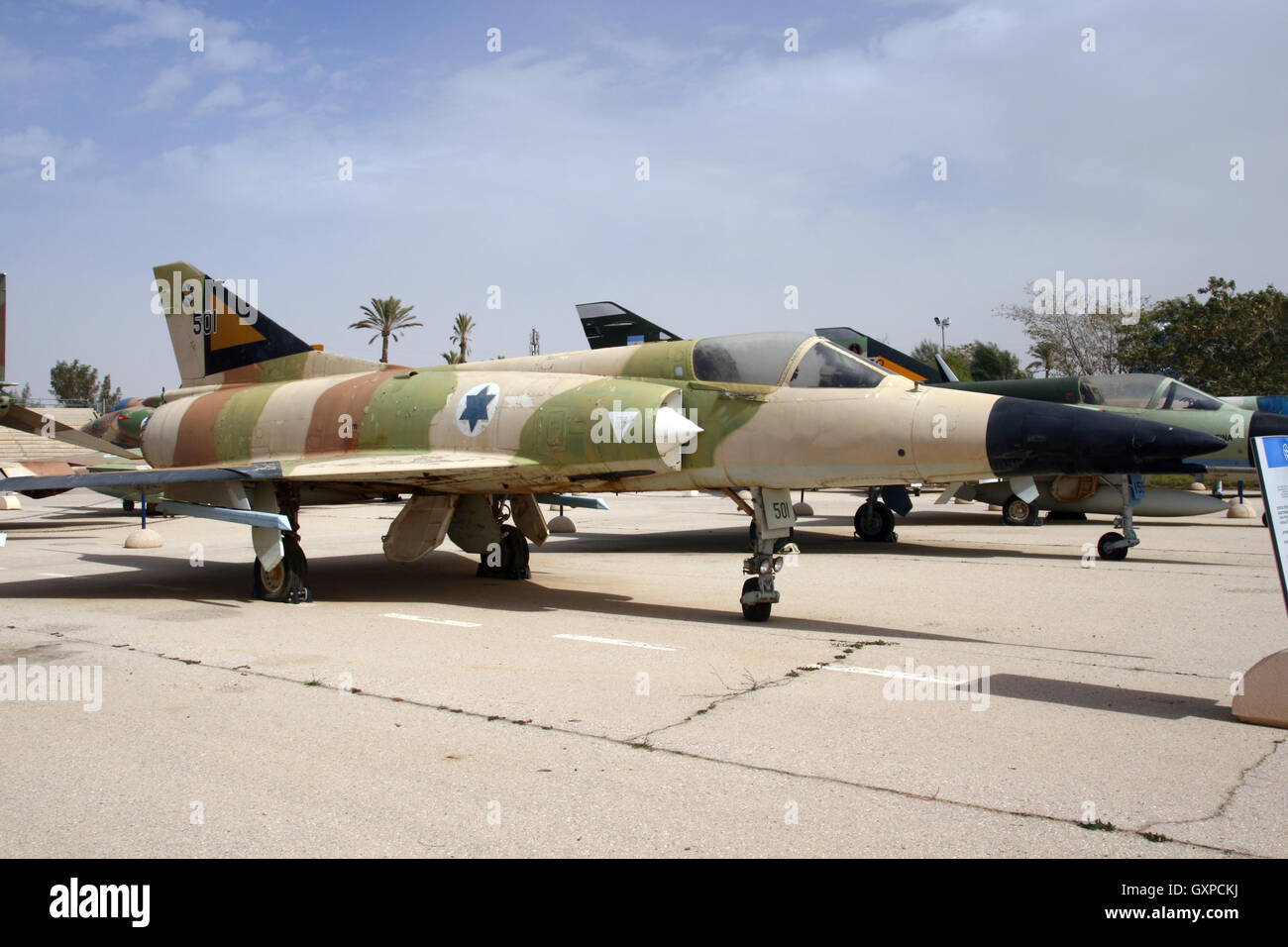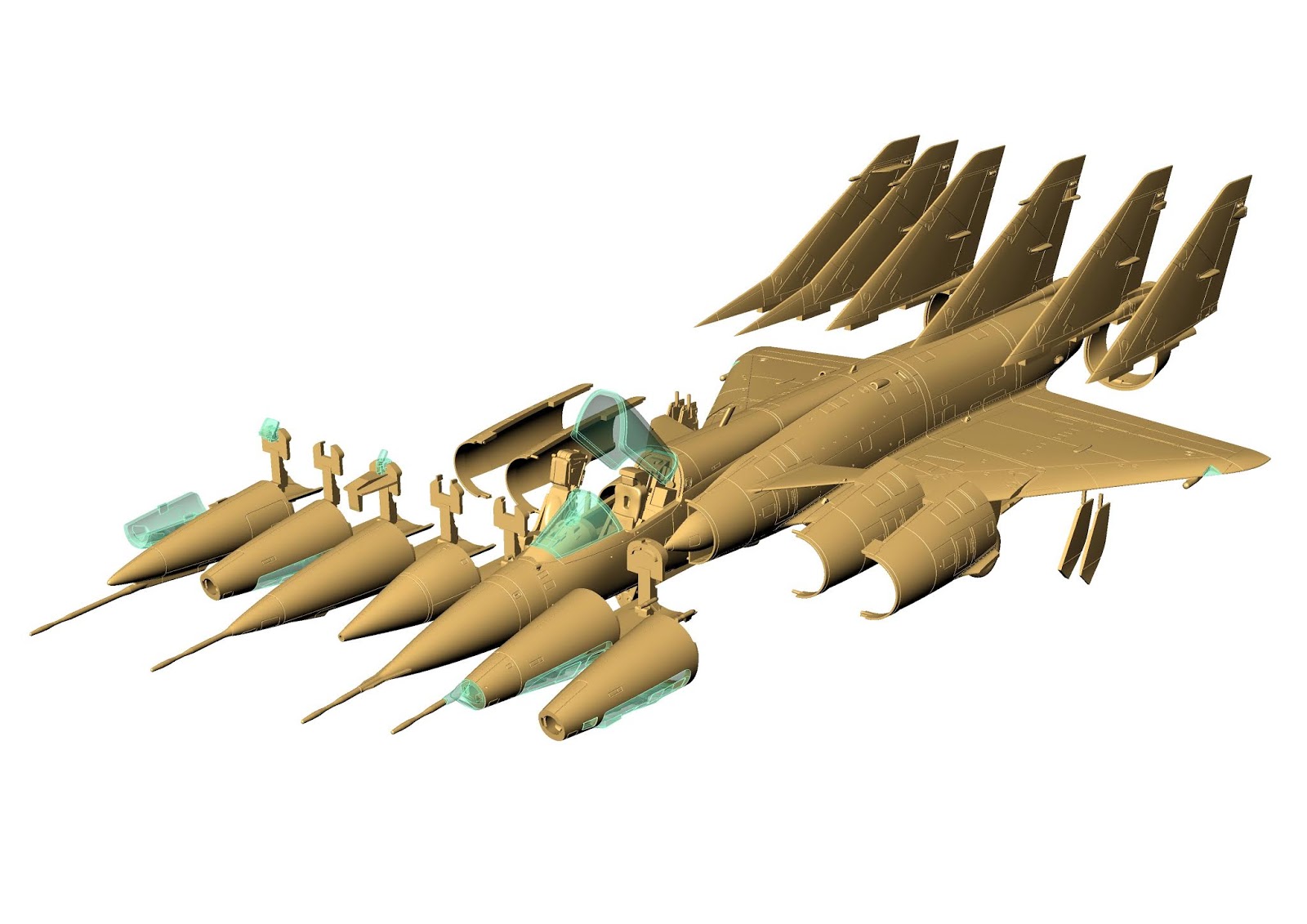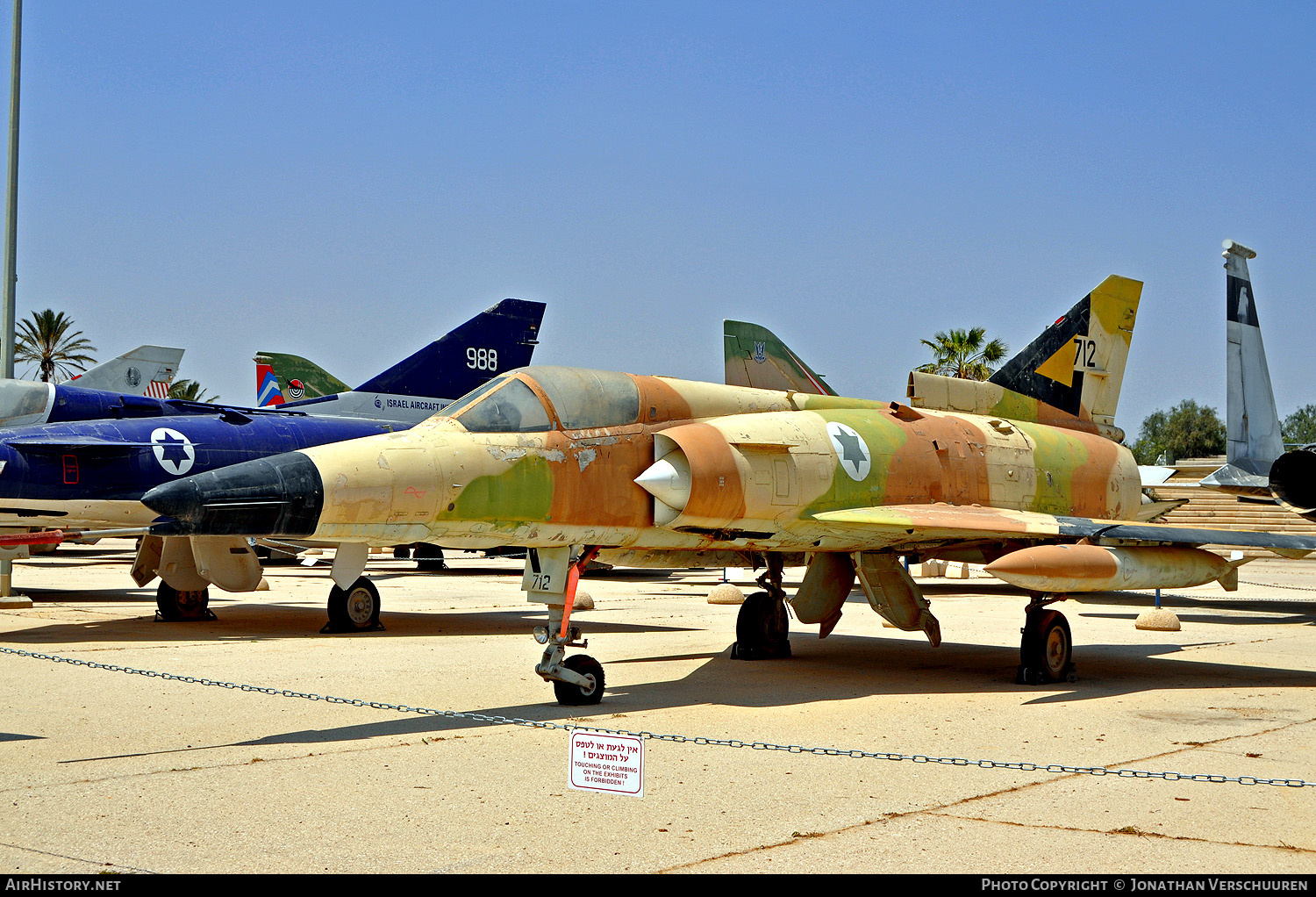Nesher Aircraft - The Neshers proved to be good fighters and overcame their adversaries (MiGs and Sukhois) with relative ease. The first aerial victory of a Nesher took place on January 8, 1973, when 4 Neshers from the "First Fighter" squadron escorted F-4 Phantoms into Syria to attack a terrorist base.
In an engagement with Syrian MiG-21s, 6 MiGs were shot down, two by the Neshers. The Neshers did not just go out on interception missions: they also carried out several attack sorties in the Golan Heights and on the southern front.
Nesher Aircraft

The action was intense, with every pilot carrying out numerous sorties every day. In 1975 the first Kfirs entered service, and the Nesher was gradually relegated to a less central role. All the Neshers were concentrated in two squadrons, and were transferred - in late 1976 - to Eitam Airbase, which had been newly dedicated in the northern Sinai.
Design And Development
The Nesher was identical to the Mirage 5, except for the use of some Israeli avionics, a Martin-Baker zero-zero ejection seat, and provisions for a wider range of AAMs (Air-to-Air Missiles), including the Israeli Shafrir heat
-seeking missile. Fifty-one Nesher fighters (Nesher S) and ten Nesher two-seat trainers (Nesher T) were built in all. Israel had to replace more than 60 aircraft lost during the Six Day War and the War of Attrition which followed.
Before the war Israel began the cooperation with Dassault to build the Mirage 5 and it was eventually built by Israel and named Raam in Hebrew (thunder). Officially, Israel built the aircraft after obtaining complete blueprints.
However, some sources claim Israel received 50 Mirage 5s in crates from the French Air Force (AdA), while the AdA took over the 50 aircraft originally intended for Israel.[2][3][4] In the 1979 contract with IAI, the Argentine Air Force stipulated that the Daggers would be equipped with new avionics and HUD systems to take them to the Kfir C.2 (and beyond in some subsystems) standard.
The program, named Finger, was underway in 1982 when the Falklands War broke out. With the war over, as some of these systems were made by the British Marconi Electronic Systems, they needed to be replaced after an arms embargo was imposed by the UK.

The replacement of such systems took the planes to the final Finger IIIB standard mainly by replacing the British equipment with French-built Thomson-CSF.[8] Also known as "Ha'Tsipor Barzel" (The Iron Bird Squadron), this unit formed in 1976 with Mirage/Nesher aircraft from 101 sqn, and was
later supplemented by 117 sqn aircraft. Originally based at Eitam, the unit moved to Matred Ramon in April 1982, when Eitam was handed back to Egypt under the Camp David Agreement. It is reported that the unit then converted to Kfir C-2s, but this is unconfirmed.
The Israel Aircraft Industries Nesher (Hebrew: נשר, "Vulture" - often mistranslated as "Eagle") is the Israeli version of the Dassault Mirage 5 multi-role fighter aircraft. Most were later sold to the Argentine Air Force as Daggers, and later upgraded as Fingers.
During the 1982 Falklands War, they were deployed to the southern naval airbase of Río Grande, Tierra del Fuego, and an airfield in Puerto San Julián and despite the distance to their targets and lack of aerial refueling capability, managed to make 153 sorties against both
ground and naval targets on the 45 days of operations. In the last role, they damaged HMS Antrim, Brilliant, Broadsword, Ardent, Arrow and Plymouth.[6] Eleven Daggers were lost in combat (nine by AIM-9L Sidewinders fired from Sea Harriers and two by surface to air missiles).[7]
The Nesher enjoyed great success in the Yom Kippur War with dozens of Egyptian, Syrian and Libyan aircraft shot down, the "First Fighter" squadron alone scoring 59 victories for the loss of only 4 planes. The Nesher squadron from Etzion was one of the leading squadrons, tallying 42 kills without a single plane lost.
By the end of the war Nesher 510 had shot down 13 enemy aircraft while 561 had shot down 12. According to the statistics published after the war, there were 117 dogfights in the course of the Yom Kippur War (65 over Syria and 52 over Egypt).

227 enemy planes were shot down in these confrontations, and only six Israeli planes were shot down (they had been on interception missions, and were either hit by cannon fire or by surface-to-air missiles). Nesher production was phased out from 1978 to make way for an improved Mirage derivative that had been planned in parallel, in which the Atar engine was replaced by an Israeli-built General Electric J79 engine, the engine used on the American Lockheed F-104 Starfighter
and McDonnell Douglas F-4 Phantom II fighters. The result was the IAI Kfir. The Mirage III, although an excellent platform, suffered from a number of faults in its engine and radar system. Furthermore, in the clear skies over the Middle East there was no use for the entire avionics package provided by the French manufacturer.
In January, 1969 the French government arms embargo on Israel (on the eve of the Six Day War and after the Israeli attack of the airport of Beirut, in 1969) prevented the first 30 Mirage 5 aircraft (which were already paid for by Israel)
plus optional 20 from being delivered and cut off support for the existing Mirage IIICJ fleet. Dassault Aviation had developed the Mirage 5 at the request of the Israelis, who were the main foreign customers of the Mirage III.
The Israeli Air Force (IAF) wanted the next version to have less all-weather capability in exchange for improved ordnance carrying capacity and range as the weather in the Middle East is mostly clear. and finally with the embargo following the Israeli commando raid on Beirut airport in December 1968 (following an attack by Palestinian terrorists on an El Al aircraft).
France refused to deliver the 50 Mirage 5 aircraft already ordered by Israel and instead used them to arm its own air force. In the late 1960s the close ties between France and Israel began to cool down, first with the French weapons embargo during the Six Days War (the Arabs were armed by the Soviets so the embargo mainly hurt Israel)
The first Nesher prototype flew in September 1969, with production deliveries to the IAF beginning in May 1971, ending in February 1974. These aircraft performed well during the 1973 Yom Kippur War, claiming over a hundred kills.

Under the codename "Nesher" (Vulture) Israel Aircraft Industries secretly began the construction of the new fighter in its Ben Gurion Airport facilities. On March 21st, 1971 the first aircraft took to the air and supplies to the IAF began by May of the same year.
At first some disappointment was voiced over the aircraft's air-to-air characteristics but these were gradually silenced and finally disappeared after the aircraft's excellent performance during the Yom-Kippur war of 1973. In total 51 single seat Nesher A's and a further 10 double seat
B's were built before production ended in 1974. Survivors of Israeli aircraft were refurbished and exported to the Argentine Air Force in two batches, 26 in 1978 and 13 in 1980, under the name Dagger, comprising 35 Dagger A single-seat fighters and 4 Dagger B two-seat trainers.
The Nesher (Vulture) was the first fighter to be produced in Israel, thus paving the way for the appearance of more advanced planes like the Kfir and Lavi. The IAF saw the Nesher as a temporary expedient for reinforcing Israel's air power, a sort of intermediate phase before the more advanced models made their entry.
When the better planes arrived upon the scene, the Nesher was phased out. The Neshers served in the IAF for just 10 years, and reached the apex of their glory in the Yom Kippur War, during which they scored numerous kills.
In 1981, the Kfir had supplanted the Nesher in Heyl Ha'avir, and the Neshers were renovated, for sale overseas. Exported as the "Dagger", 35 single seat examples were sold to Argentina along with 4 two seaters.
These took part in the Falklands War of 1982, attacking the British task force sent to recapture the islands, facing Sea-Harriers during the landing at San Carlos. There were still 25 Daggers in service with the Argentinian Air Force (FAA) in 1993.

The Nesher had simpler avionics than the Mirage IIIC, although it was found by Israeli pilots to be slightly less maneuverable. However, it had longer range and bigger payload. The reduced maneuverability did not prevent the Nesher from giving a good account of itself in air combat during the Yom Kippur war.
When the Yom Kippur War broke out, in October of 1973, the IAF had 40 Nesher planes in its ranks in four squadrons, serving in the First Combat Squadron and in the two new squadrons. The type equipped 4 fighter squadrons - "First Fighter" squadron, "First Jet" squadron, "Hornet" & "Guardians of the Arava".
They formed a new unit, 6th Air Group, and were immediately enlisted with the help of the 8th Air Group (Mirage IIIEA) and the Peruvian Air Force, already a user of the Mirage 5, due to the escalating crisis with Chile of that year
. After contacts with Israel Dassault agreed to develop a new aircraft, based on the Mirage III but following Israeli guidelines and requirements. The Mirage 5 was conceived to answer Israeli requirements. The Mirage 5, equipped with the same airframe as the Mirage IIIC and engine as the Mirage IIIE, was conceived as a daylight ground strike fighter (radar replaced by a simplified navigation and attack system).
This aircraft was radarless, but flew higher and faster and also contained more fuel than its predecessor. First flown on May 19th, 1967, this aircraft was to become the Mirage 5 and Israel ordered 50 of the type.
Although they were originally intended for attack missions, in the course of the war the Neshers were primarily used in air-to-air combat. The IAF command decided to use the Phantoms, Skyhawks and Sa'ars against ground targets, and assigned the Mirages and Neshers the task of fighting enemy aircraft and establishing air superiority over the battle zones.
One of the first victories of the war was not an aircraft but an AS-5 Kelt air to ground missile launched against Tel-Aviv by an Egyptian Tu-16 Badger on the first day of the war, October 6th, 1973. When Libyan Mirage
![Mkm144133] Mirage Iiidp/5Sdd/5Dm/Nesher T Two-Seater 'Asia & Africa'](https://www.4pluspublications.com/wp-content/uploads/2022/04/MKM144133-Mirage-IIID-Nesher-Two-seater-Asia-Africa_box.jpg)
5s entered the fighting all Israeli Mirages and Neshers were marked with large yellow triangles bordered by a thick black frame to prevent a case of mistaken identity. At least two Mirage 5s were shot down by Neshers, as well as an Israeli Phantom shot down by mistake, the navigator and the pilot, a former Nesher squadron commander, parachuting to safety.
The first Nesher landed in the First Combat Squadron's base at Hatzor in May of 1971, with veteran test pilot Danny Shapira at the controls. In the months that followed, additional Nesher planes equipped this squadron, making up for the insufficient number of Mirage IIIs and raising the number of serviceable planes in the squadron.
When the rate of production picked up at the Nesher assembly line at IAI, two new squadrons could be established, based solely on the Neshers. The first new squadron inaugurated 'Etzion Airbase at 'Bik'at Hayareakh' ('Valley of the Moon') near Eilat, in September of 1972, and the second was founded in March of 1973 at Hatzor.
Between 1978 and 1981 the Mirages and Neshers were retired from Israeli service, replaced with Israel's next locally built fighter, the Kfir. The Kfir was a significantly more advanced plane than the Nesher, boasting better performance as well as more sophisticated systems, and upgrading the Neshers was not deemed to be a worthwhile investment.
The need in Israel to replace more than 60 aircraft lost during the Six Days War and the ongoing War of Attrition that followed prompted Israel to privately acquire the Mirage 5 blueprints from Dassault and to secure the engine blueprints through espionage.
Israel Aircraft Industries secretly began the construction of the new fighter in its Ben Gurion Airport facilities. Production began in 1969[5] with the first empty cell (no weapons, no electronics, no seat, no engine) delivered directly from Dassault Aviation because spare parts were not subjected to the embargo.[1]
The first Raam A was delivered in May, 1971. In November, 1971 the plane was renamed Nesher.[1] This was bad news for the Israeli Air Force, who needed the new Mirage to compensate for the losses of the Six Day War and was still using the origin of this version derived from the Mirage III.
Israel then decided to build this plane (Raam A and B project)[1] as it had the necessary plans, although Israel did not officially obtain a manufacturing license.
israeli nesher, israeli mirage iii, iai dagger, iai kfir c2, israeli mirage jet, israeli fighter jet, iaf nesher, 1979 iai kfir